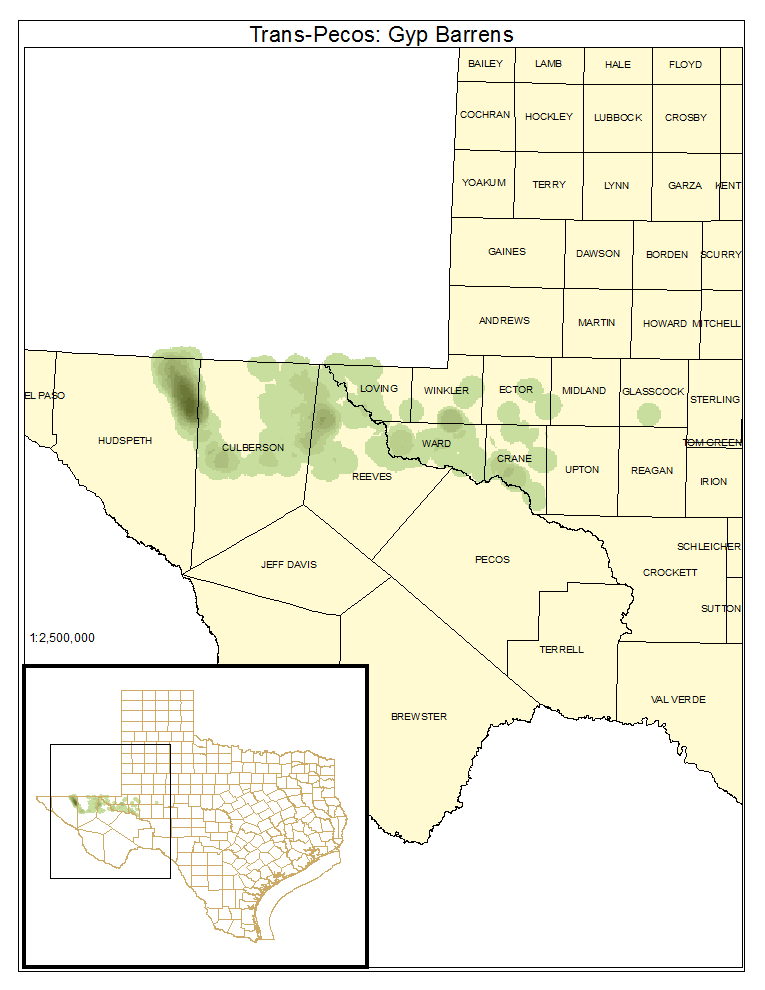Chihuahuan Gypsophilous Grassland and Steppe
Geology
Extensive occurrences associated with the Permian Castile Formation and alluvium within evaporative bolsons. The system also occupies scattered occurrences of exposed gypsite and alluvium of evaporative ponds and swales receiving deposition from eroding gypsiferous formations.
Landform
Rolling uplands with minor erosional scarps as well as level basins and drainages.
Soils
Gyp, gyp hills, vegetated gypsum dunes, gyp upland and gyp (desert grassland) ecoclasses.
Parent Description
Occurrences may be sparsely vegetated, grassy, or shrublands. Also included here are the gypsum dunes. Sites occupied by this system may be rolling and erosional uplands, as well as alluvium of basins and drainages. Gypsophilous species are frequently encountered, including Sporobolus nealleyi (gypgrass), Bouteloua breviseta (gyp grama), Tiquilia hispidissima (rough coldenia), Nama carnosum (sand nama), Sartwellia flaveriae (threadleaf glowwort), Gaillardia multiceps (onion blanket-flower), Anulocaulis spp. (ringstems) and Selinocarpus spp. (moonpods). Other species that may be encountered include Atriplex canescens (four-wing saltbush), Ephedra torreyana (Torrey jointfir), Calylophus hartwegii (Hartweg evening primrose), Poliomintha incana (hoary rosemary-mint), Yucca torreyi (Torrey’s yucca), Sporobolus airoides (alkali sacaton), Scleropogon brevifolius (burrograss), Prosopis glandulosa (honey mesquite), Larrea tridentata (creosotebush), Condalia ericoides (javelina bush), and Sporobolus cryptandrus (sand dropseed). This system includes the gypsum dunes which range from sparsely vegetated to scattered shrubs with patchy herbaceous cover. In addition to many of the species above, the composition of the dunes includes Artemisia filifolia (sand sage), Psorothamnus scoparius (broom pea), Poliomintha incana (hoary rosemary-mint), Dalea lanata (wooly dalea), Andropogon hallii (sand bluestem), Sporobolus giganteus (giant dropseed), Dimorphocarpa wislizeni (spectaclepod), Tidestromia lanuginosa (wooly tidestromia), Krameria lanceolata (trailing ratany), Mentzelia spp. (blazingstar), and Yucca elata (soaptree yucca).
Ecological Mapping Systems
Trans-Pecos: Gyp Barrens
Sparsely vegetated gyp sites.
Distribution Map

Photos

Public Land Occurrence
Trans-Pecos: Gyp Shrubland
Gyp sites with significant shrub cover with species including Atriplex canescens (four-wing saltbush), Prosopis glandulosa (honey mesquite), Larrea tridentata (creosotebush), Condalia ericoides (javelina bush), Yucca torreyi (Torrey's yucca), and/or Ephedra torreyana (Torrey jointfir).
Distribution Map

Photos

Public Land Occurrence
Trans-Pecos: Gyp Grassland
Gyp sites with sparse shrub layer and with herbaceous layer present, including herbaceous species mentioned in the system description.
Distribution Map

Photos

Public Land Occurrence
Trans-Pecos: Gyp Dune
In addition to other species mentioned for the system, the composition of the dunes includes Artemisia filifolia (sand sage), Psorothamnus scoparius (broom pea), Poliomintha incana (hoary rosemary-mint), Dalea lanata (wooly dalea), Andropogon hallii (sand bluestem), Sporobolus giganteus (giant dropseed), Achnatherum hymenoides (Indian ricegrass), Dimorphocarpa wislizeni (spectaclepod), Tidestromia lanuginosa (wooly tidestromia), Krameria lanceolata (trailing ratany), Mentzelia spp. (blazingstar), and Yucca elata (soaptree yucca).
Distribution Map

Photos
